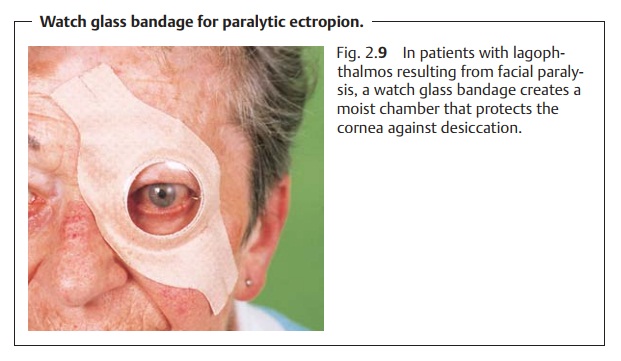Chapter: Ophthalmology: The Eyelids
Ectropion

Ectropion
Definition
Ectropion refers to the condition in which the
margin of the eyelid is turned away from the eyeball. This condition almost
exclusively affects the lower eye-lid. The following forms are differentiated
according to their origin (see also Etiology):
❖Congenital ectropion.
❖Senile ectropion.
❖ Paralytic ectropion.
❖ Cicatricial ectropion.
Epidemiology:
Senile ectropion is the most prevalent form; the paralytic
andcicatricial forms occur less frequently. Congenital ectropion is very rare
and is usually associated with other developmental anomalies of the eyelid and
face such as Franceschetti’s syndrome.
Etiology:
❖Congenital ectropion: See Epidemiology.
❖ Senile ectropion: The palpebral ligaments and tarsus may become
laxwith age, causing the tarsus to sag outward (Fig. 2.8).

❖ Paralytic ectropion: This is caused by facial paralysis with
resulting loss offunction of the orbicularis oculi muscle that closes the
eyelid.
❖ Cicatricial ectropion: Like cicatricial entropion, this form is usually asequela of infection or injury.
Symptoms and diagnostic considerations:
Left untreated, incomplete clo-sure of the
eyelids can lead to symptoms associated with desiccation of the cornea
including ulceration from lagophthalmos. At the same time, the ever-sion of the
punctum causes tears to flow down across the cheek instead of draining into the
nose. Wiping away the tears increases the ectropion. This results in chronic
conjunctivitis and blepharitis.
Treatment:
❖Congenital ectropion: Surgery.
❖Senile ectropion: Surgery is indicated. A proven procedure is to
tighten thelower eyelid via a tarsal wedge resection followed by horizontal
tightening of the skin.
❖ Paralytic ectropion: Depending on the severity of the disorder,
artificialtear solutions, eyeglasses with an anatomic lateral protective
feature, or a “watch glass” bandage (Fig. 2.9) may be sufficient to prevent desiccation of the cornea. In
severe or irreversible cases, the lagophthalmos is treated surgically via a
lateral tarsorrhaphy.

❖ Cicatricial ectropion: Plastic surgery is often required to correct
the eyeliddeformity.
Prognosis:
The prognosis is favorable when the disorder is treated promptly.Sometimes several operations will be required. Surgery is more difficult where scarring is present.
Related Topics